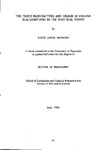THE TRADE MANUFACTURE AND DESIGN OF ENGLISH BLACKSMITHING IN THE POST WAR PERIOD
| dc.contributor.author | HAWKINS, DAVID JAMES | |
| dc.contributor.other | Faculty of Arts, Humanities and Business | en_US |
| dc.date.accessioned | 2013-10-23T09:24:20Z | |
| dc.date.available | 2013-10-23T09:24:20Z | |
| dc.date.issued | 1996 | |
| dc.identifier | NOT AVAILABLE | en_US |
| dc.identifier.uri | http://hdl.handle.net/10026.1/2303 | |
| dc.description.abstract |
Blacksmithing has undergone a dramatic transformation in the last twenty five years. This study examines the changes and the context within which they have taken place. The effects upon the products of the blacksmith are considered through empirical research and practical work. The working methods and philosophies of blacksmiths representative of a continuity of traditions and innovatory practice are investigated through interviews and other approaches. From its origins as a rural and industrial craft, blacksmithing has emerged in the form of art-blacksmithing. Institutional and government intervention, new technologies and markets provide the context in which the ideologies and practices are examined. It is argued that these new blacksmiths are selfconscious designer-makers who are technically innovative, and commercially aware, operating successfully between and within the cultural and commercial arenas. In combining practical and decorative functionalism, and producing site-specific art work at a competitive price, artist blacksmiths successfully inhabit the worlds of art, industry, trade and craft, often simultaneously. | en_US |
| dc.language.iso | en | en_US |
| dc.publisher | University of Plymouth | en_US |
| dc.title | THE TRADE MANUFACTURE AND DESIGN OF ENGLISH BLACKSMITHING IN THE POST WAR PERIOD | en_US |
| dc.type | Thesis | |
| dc.identifier.doi | http://dx.doi.org/10.24382/1509 |
Files in this item
This item appears in the following Collection(s)
-
01 Research Theses Main Collection
Research Theses Main


